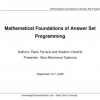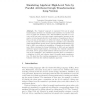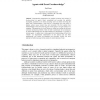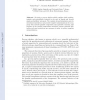BIRTHDAY
2005
Springer
15 years 15 days ago
2005
Springer
BIRTHDAY
2005
Springer
15 years 15 days ago
2005
Springer
The “classical” approach to represent Petri nets by graph transformation systems is to translate each transition of a specific Petri net to a graph rule (behavior rule). This ...
BIRTHDAY
2005
Springer
15 years 15 days ago
2005
Springer
Modularization is a well-known concept to structure software systems as well as their specifications. Modules are equipped with export and import interfaces and thus can be connec...
BIRTHDAY
2005
Springer
15 years 15 days ago
2005
Springer
Computational experiments are reported involving the concept of foreknowledge, an agent’s direct, unmediated and accurate, but possibly incomplete, awareness of its future includ...
BIRTHDAY
2005
Springer
15 years 15 days ago
2005
Springer
abstract. In this paper we investigate a formalism for solving planning problems based on ordered task decomposition using Answer Set Programming (ASP). Our planning methodology is...
BIRTHDAY
2005
Springer
15 years 15 days ago
2005
Springer
BIRTHDAY
2005
Springer
15 years 15 days ago
2005
Springer
Undecidability results in rewriting have usually been proved by reduction from undecidable problems of Turing machines or, more recently, from Post’s Correspondence Problem. Ano...
BIRTHDAY
2005
Springer
15 years 15 days ago
2005
Springer
Abstract. We study a process algebra which combines both nondeterministic and probabilistic behavior in the style of Segala and Lynch’s simple probabilistic automata. We consider...
BIRTHDAY
2005
Springer
15 years 15 days ago
2005
Springer
This paper addresses the question of factoring a logic into families of (generally simpler) components, estimating the top– down perspective, splitting, versus the bottom–up, s...
BIRTHDAY
2005
Springer
15 years 15 days ago
2005
Springer
This paper is a guided tour through the theory of fibring as a general mechanism for combining logics. We present the main ideas, constructions and difficulties of fibring, from ...




